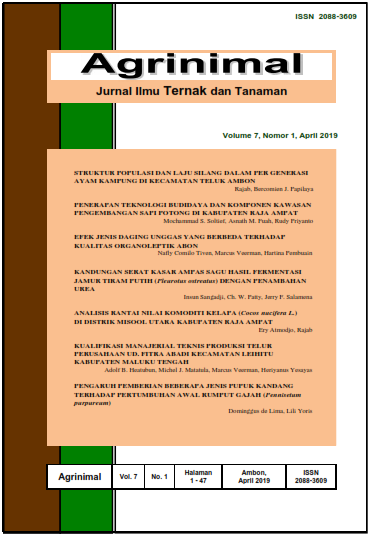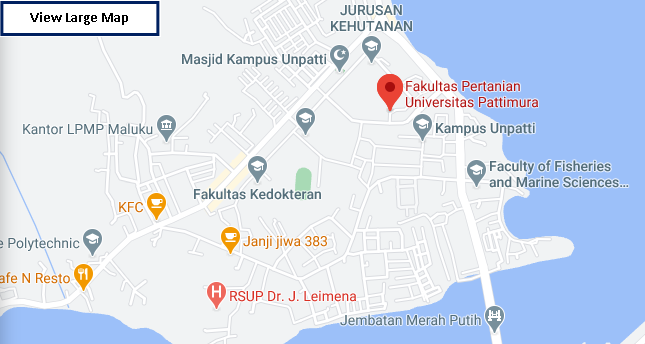KUALIFIKASI MANAJERIAL TEKNIS PRODUKSI TELUR PERUSAHAAN UD. FITRA ABADI, KECAMATAN LEIHITU, KABUPATEN MALUKU TENGAH
Abstract
The technical managerial ability to produce eggs from farmers and farm company managers is an indicator of how well businesses organize successful production and business activities. This study aims to determine the technical indicators of production efficiency in the laying hens company UD. Fitra Abadi. The study used a survey method, the location was selected purposively, and the study lasted 31 days in October 2018. The sample used was one cage block with 2,100 hens laying hens. The results showed the laying hens, UD. Fitra Abadi applies a technology package that is lower in capacity by mixing shop food (35%), corn feed (45%), and bran feed (20%). Egg production produced an average of 1,738 eggs per day (82.76% of 2,100 chickens) is below the best capacity of the peak egg-laying period of 95%. Technical indicators of production show the average production of eggs per kg of food 6.43 eggs, marginal production of -0.3 eggs, and elasticity of -0.047. The efficiency of the company's production becomes negative, and the company operates in a loss phase.
Downloads
References
Adnan, K. 2011. Pertumbuhan Berat Badan yang Optimal pada Ayam Petelur/Layer. http://kuntaadnan.blogspot.com./2011/07/pertumbuhan-beratbadan-yang-optimal.html. [11/03/2019].
Aydin, S., A.T Cetin, and G. Ozer. 2007. The Relationship Between Marketing and Product Development Process and Their Effects on Firm Performance. Academy of Marketing Studies Journal. 11 (1): 53-68.
Banaeian, N., and M. Zangeneh. 2011. Estimating production function of walnut production in Iran using Cobb-Douglas method. Agricultura Tropica et Subtropica. 44 (4): 189-201.
Burja, C., and V. Burja. 2016. Farms Size and Efficiency of The Production Factors in Romanian Agriculture. Economics of Agriculture. 63 (2): 361-374.
Chigbo, N. D. 2014. Management as a Factor of Production and as an Economic Resource. International Journal of Humanities and Social Science. 4(6): 162 – 166.
Clercq, D.D., and P. Arenius. 2006. The Role of Knowledge in Business Start-Up Activity. International small business journal. 24(4): 339-358.
Gajdzik, B., and R. Gawlik. 2018. Choosing the Production Function Model for an Optimal Measurement of the Restructuring Efficiency of the Polish Metallurgical Sector in Years 2000–2015. Metals. 8(1): 23-33.
Glendoh, S.H. 2001. Pembinaan dan Pengembangan Usaha Kecil. Jurnal Manajemen & Kewirausahaan. 3(1): 1–13.
Izekor, O.B., and G. O. Alufohai. 2014. Production Elasticities, Return to Scale and Allocative Efficiency in Yam Production in Edo State, Nigeria. Agrosearch. 14(2): 179-190.
Kristianto, Y., M. Ajmal, R. Addo Tenkorang, and M. Hussain. 2012. A study of technology adoption in manufacturing firms. Journal of Manufacturing Technology Management. 23(2): 198-211.
Nicholson, W., and C. Snyder. 2008. Microeconomic Theory. Basic Principles and Extensions. Tenth Edition. USA: Thomson South-Western.
Reiff, A., A. Sugar, and E. Surányi. 2002. Productive Efficiency in The Hungarian Industry. Hungarian Statistical Review. Vol. 7: 45-74.








